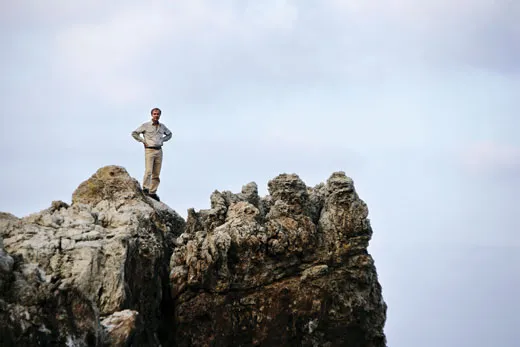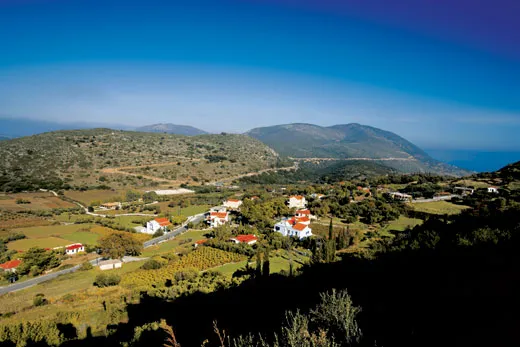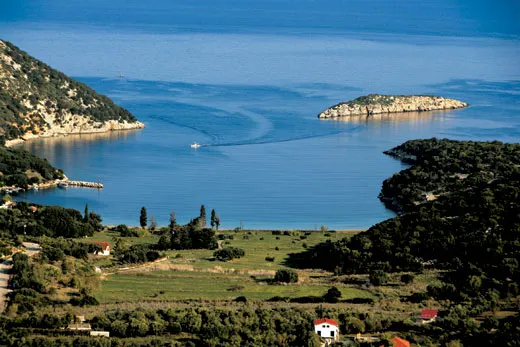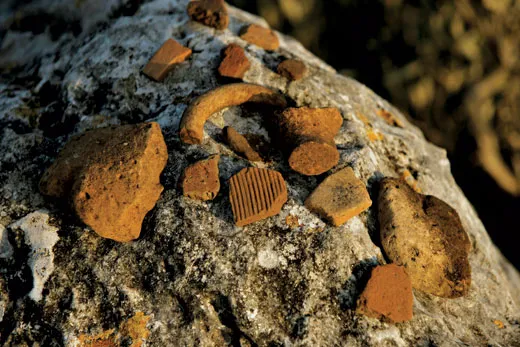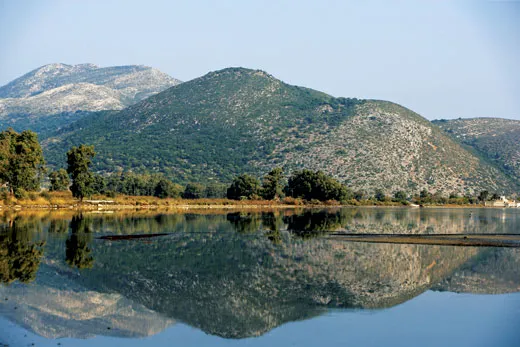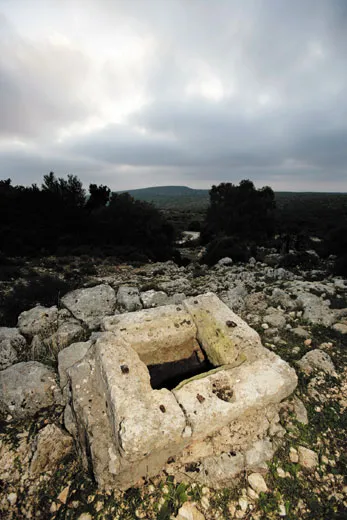Odyssey’s End?: The Search for Ancient Ithaca
A British researcher believes he has at last pinpointed the island to which Homer’s wanderer returned
Editor’s Note: This article was adapted from its original form and updated to include new information for Smithsonian’s Mysteries of the Ancient World bookazine published in Fall 2009.
Robert Bittlestone is standing above the village of Petrikata, looking over red-tile roofs down upon a narrow isthmus that connects the two parts of the Greek island of Cephalonia, off Greece’s western coast. In the valley below, farmers in overalls are harvesting olives. A light breeze carries the scent of oregano and thyme. “This looks like solid ground that we’re standing on,” Bittlestone says. “But everything under us is rockfall. Across that valley was the ancient island of Ithaca.”
Bittlestone, a British management consultant by profession, believes he has solved a mystery that has bedeviled scholars for more than 2,000 years. In Odysseus Unbound, published in 2005 by Cambridge University Press, he argues that a peninsula on the island of Cephalonia was once a separate island—Ithaca, the kingdom of Homer’s Odysseus some 3,000 years ago. He believes that the sea channel dividing the two islands was filled in by successive earthquakes and landslides, creating the peninsula of Paliki, as it is known today.
Like Heinrich Schliemann, the businessman who discovered the site of ancient Troy in the 1870s, and Michael Ventris, the architect who deciphered the written language of Minoan Crete in the 1950s, the 57-year-old Bittlestone is part of an honorable tradition of inspired amateurs who have made extraordinary discoveries outside the confines of conventional scholarship. “Bittlestone’s insight is brilliant,” says Gregory Nagy, director of the Center for Hellenic Studies, in Washington, D.C. “He has done something very important. This is a real breakthrough convergence of oral poetry and geology, and the most plausible explanation I’ve seen of what Ithaca was in the second millennium B.C. We’ll never read the Odyssey in the same way again.”
Even more provocatively, Bittlestone, who was able to draw upon sophisticated technological tools unavailable to scholars before him, believes that events like those described in the Odyssey may well have taken place, and that telltale landmarks from the hero’s adventures on Ithaca can be found on Cephalonia’s Paliki peninsula. “I find most events that are described on the island perfectly credible,” he says, adding that the chapters recounting Odysseus’ fantastical adventures among magical figures—the sea monster Scylla and man-eating whirlpool Charybdis, or the enchantress Circe—obviously owe a great deal to the poetic imagination.
“By far the most important part of this is the argument that modern Paliki was ancient Ithaca,” says James Diggle, a professor of Greek and Latin at Cambridge University. “Of this, I haven’t the slightest doubt. It’s irresistible, and supported by geology. The other part is more speculative. But once you go over the terrain, there is an extraordinary match.”
Since ancient times, the location of Homer’s Ithaca has been one of literature’s great conundrums. The third-century B.C. geographer Eratosthenes sighed, “You will find the scene of the wanderings of Odysseus when you find the cobbler who sewed up the bag of the winds.” Some dismissed Homer’s geography as a poet’s guesswork. As the renowned classicist Bernard Knox once put it, “When Homer’s characters move to mainland Greece and its western offshore islands, confusion reigns.”
Modern scholars have proposed numerous locations, some as far afield as Scotland or the Baltic. The most obvious candidate was the present-day island of Ithaca, which lies east of Cephalonia. But it doesn’t fit Homer’s description:
Around her a ring of islands circle side-by-side,
Doulichion, Same, wooded Zachynthos too, but mine
lies low and away, the farthest out to sea,
rearing into the western dusk
while the others face the east and breaking day.
Scholars have long agreed that ancient and modern Zachynthos are one and the same. Similarly, ancient Same was certainly the main body of modern Cephalonia, where a large town named Sami still exists. But modern Ithaca—a few miles east of Cephalonia—was hardly “the farthest out to sea,” and its mountainous topography doesn’t fit Homer’s “lying low” description. (Bittlestone believes ancient Doulichion became modern Ithaca after refugees came there following an earthquake or other disaster and changed its name.) “The old explanations just felt unsatisfactory,” he says. “I kept wondering, was there possibly a radical new solution to this?” Back home near London, he pored over maps and satellite images. If Paliki had once been a separate island, he mused, it would indeed have been the one “farthest out to sea.”
Then Bittlestone hit pay dirt. Perusing the section on Cephalonia in the ancient author Strabo’s Geography, the most important source of its kind for ancient geographical knowledge, Bittlestone came across the following passage: “Where the island is narrowest it forms a low isthmus, so that it is often submerged from sea to sea.” According to Strabo’s second-century B.C. sources, Cephalonia had been, at times, two islands. Strabo’s description suggested that the channel that separated Cephalonia from its present-day peninsula had gradually filled in.
Bittlestone has been convinced from the start that he was on the right track. In 2003, he traveled to Cephalonia, rented a jeep and began crisscrossing the isthmus, a narrow, rugged neck of land connecting the larger landmass to the Paliki peninsula. He was looking, he says, “for traces of a former channel” when he noted zigzagging ravines running the length of the five-mile-long isthmus. The chasms, up to 300 feet deep in some places, suggested the possible route of an ancient watercourse.
Bittlestone had already learned that Cephalonia lay on one of the most unstable geologic fault lines in the world. For eons, the African and Eurasian tectonic plates have been colliding a few miles off the Paliki coast, creating a steady upthrust that periodically explodes in violent earthquakes. The worst in modern times, in 1953, leveled almost every building on the island, causing 90 percent of its residents to flee. Perhaps, Bittlestone speculated, a giant earthquake had thrust “Strabo’s channel” (as he came to call it) up above sea level, leaving it literally high and dry.
In 2003, Bittlestone contacted John Underhill, a professor of geography at the University of Edinburgh. Underhill, who has studied the geology of Cephalonia for more than 20 years, told him that geological uplift on such a large scale was impossible. But he was sufficiently intrigued to meet Bittlestone on Cephalonia for a firsthand look.
Underhill immediately noted that the half-mile-wide isthmus was a geologic “mess” of rocks of different ages—evidence of avalanches from the steep mountains on either side. As landslide followed landslide over the centuries, the debris could have extended farther across the isthmus, layer upon layer, to create the rugged hills. “I thought it would be easy to disprove Bittlestone’s thesis,” he says, “but it wasn’t. Suddenly I thought, crikey, there might really be a channel down there.”
The more he looked the more certain he became that Cephalonia had once been two islands. “The only credible explanation for this geological formation is that some of it slid down from the mountain above,” Underhill says.
Bittlestone had no doubts. “A landslip with massive kinetic energy inundated everything,” he says. “Huge chunks of mountain broke loose and thundered down. The scale of it is mind-blowing.” Bittlestone adds he is confident that eventually his investigations will show that Homer’s description of Ithaca’s location was accurate. “I’d like to be able to vindicate him,” he asserts, “by saying he wasn’t a geographical idiot. When he has his hero Odysseus saying ‘My island lies further to the west,’ it bloody well was.”
Recent follow-up research, announced last year by Bittlestone, Diggle and Underhill, dramatically bolsters the case they are making. Among other findings, teams of international scientists have shown that a 400-foot borehole drilled on the isthmus met no solid limestone—only loose rockfall. A Greek Geological Institute survey pinpointed a submerged marine valley, consistent with a onetime sea channel between modern Paliki and Cephalonia. The new findings, says Underhill, represent “very encouraging confirmation of our geological diagnosis.”
There is a deep seductiveness to the second, yet untested, part of Bittlestone’s theory, that the Odyssey’s landscape can still be found on Cephalonia, like a palimpsest beneath a medieval manuscript. But attempting to identify actual places that fit a nearly 3,000-year-old narrative does present problems. For one, it is by no means certain that individuals in the poem—Odysseus; his wife, Penelope; son, Telemachus; the suitors—ever existed. Gregory Nagy is cautious. “I’m completely convinced that Paliki was Ithaca in the second millennium b.c.,” he says. “But the poem is not reportage. We should not force it to be a road map for a set of real events.”
Bittlestone has an answer for that. “Because the landscape is real, does it mean that Odysseus was a real person? Not necessarily. But it is plausible that there was a Bronze Age chieftain around whom these stories grew. I also don’t think Homer invented an imaginary landscape. There was a real Troy, a real Mycenae, a real Sparta, all of which have been rediscovered by archaeologists.”
Most scholars agree that the Odyssey was first put into writing in the eighth or seventh century b.c. But some believe, and Bittlestone concurs, that its core narrative dates as far back as the 12th century b.c., just after the Trojan War. “I am convinced,” Bittlestone says, “that in Ithaca, Homer describes a real place, and I think that he talked about locales that people knew and could recognize. His audience could say, ‘Oh, yeah, I know that cave, that mountain, that bay.’”
Cambridge University’s James Diggle is cautiously supportive. “We cannot dismiss the possibility of Bittlestone’s approach being valid,” he says. “Every place that he locates in the book can easily be located in northern Paliki—they all work. If you accept that the channel exists, and that Ithaca is Paliki—the external geography, so to speak—then you cannot dismiss the possibility that the other passages may reflect the internal geography of Ithaca.”
On a crisp day in october, Bittlestone leads me along the route that he thinks Odysseus may have followed upon his return to Ithaca. We begin at Atheras Bay, a crescent of beach enfolded by terraced groves of olive trees. Bittlestone believes this could have inspired the description of Phorcys Bay, where Odysseus—or his prototype—was put ashore by friendly Phaeacian mariners. Pointing to the mouth of the harbor, Bittlestone says it fits Homer’s description perfectly, “with two jutting headlands sheared off at the seaward side.”
It was here that Athene appeared to Odysseus in the guise of a handsome young shepherd and commanded him to find the hut of the loyal swineherd Eumaeus:
You’ll find him posted beside his swine, grubbing round
by Raven’s Rock and the spring called Arethusa,
rooting for feed that makes pigs sleek and fat,
the nuts they love, the dark pools they drink.
“So,” bittlestone says to me now, “let’s go see the pig farm.” We turn our backs on the bay and, bouncing in a jeep, follow “a rough track leading through the woods and up to the hills,” as Homer puts it. A herd of goats stares at us with yellow, inexpressive eyes, then explodes in panic, bounding away down the hillside. Soon we pass through the village of Atheras, its stucco houses painted white and yellow, its gardens lush with bougainvillea, morning glories and lemon trees. The similarity between the ancient place name Arethusa and the modern Atheras tells Bittlestone he’s on the right track. “If Arethusa spring was in the vicinity of the village of Atheras,” he says, “then Eumaeus’ pig farm and Raven’s Rock should not be far away.”
According to Homer, the swineherd’s hut was on ground “exposed to view all round,” with room for some 600 sows and 360 boars behind walls made of “quarried stones” and topped with tangles of wild pear, a technique that some Greek herdsmen still use today. In the epic, Odysseus—disguised in “squalid rags, ripped and filthy”—spends a day or two at the pig farm, then tells Eumaeus that he’s going to the palace to beg for food. Since Odysseus then asked Eumaeus to guide him there, the palace must not have been in sight of the pig farm—though it had to be near enough that Eumaeus could go there and back twice in a single day.
We turn onto a stony track and stop at an old well on a small, circular terrace. “Everywhere along here, you find springs and wells,” says Bittlestone. “Whether or not this one is the actual Bronze Age spring of Arethusa is less important than the fact that a water-bearing fault line runs just below the surface in exactly the right place for a spring with Homer’s ‘dark water’ to emerge here.”
Next we follow an old sunken path through an eerie forest of stunted wild oak trees, emerging into daylight to find an animal enclosure fenced with piled-up stones. “Clearly this area has been used for keeping animals for a long, long time,” Bittlestone says. “If you have hundreds of pigs, as Eumaeus did, you need a lot of water, and this is where you would find it.” Just past the pig farm, a crag that Bittlestone designates as Raven’s Rock looms over the trail. We catch sight, far below us, of the deep Gulf of Argostoli, and the now silted-up harbor from which Odysseus and his 12 warships could have departed for the Trojan War. From here, too, we can see where his palace might have stood, on the slopes of the conical hill of Kastelli, our destination.
Half an hour after leaving the pig farm, we park in an olive grove and begin climbing Kastelli’s steep 830-foot-high slopes, through a dense carpet of prickly underbrush. The bells of unseen goats ring in our ears. We scramble over lichen-crusted terraces that might once have supported houses, and then, near the hillcrest, clamber over traces of a defensive wall and heaps of jagged stones.
Somewhere beneath our feet, perhaps, lie ruins of the “high-walled courtyard” where Penelope’s suitors gathered and the great hall with its pillars of cypress, couches, chairs and raucous banquets. Somewhere here, perhaps, Odysseus’ despairing wife worked at her loom, spinning funeral cloth for Laertes, his aged father. (Penelope then secretly unraveled the cloth every night, having promised the suitors that she would wed one of them as soon as the cloth was completed.) Here, perhaps, with “a shield of fourfold hide” and a plumed helmet on his “heroic head,” Odysseus set to his bloody work. As Homer puts it, “Ghastly screams rose up as men’s heads were smashed in, and the whole floor ran with blood.” In the end, corpses lay heaped in the dust “like fishes the fishermen have dragged out of the grey surf in the meshes of their net onto a curving beach, to lie in masses on the sand longing for the salt water till the bright sun ends their lives.”
Bittlestone prowls the windswept summit, pointing out shards of ancient pottery—fragments of pots, wine jugs and oil jars, compacted amid generations of goat droppings and dust, the last traces of an ancient town and perhaps a palace.
Of course, the odds of finding an artifact proclaiming “Odysseus was here” are slim. But clearly, based on preliminary archaeological examinations, both the surviving walls and some of the pottery date back to the Bronze Age (c. 2000-1100 B.C.). Bittlestone gazes across the craggy landscape of Cephalonia, his blue eyes gleaming with excitement. “We don’t know what lies under these tumbled stones,” he says, as much to himself as to me, “but something was surely going on here.”
Editor's Note, Sept. 3, 2008: For more than 2,000 years, scholars have been mystified—and intrigued—by a question central to our understanding of the ancient world: where is the Ithaca described in Homer’s Odyssey? The descriptions in the epic poem do not coincide with the geography of the modern island of Ithaca, one of the Ionian islands off the western coast of Greece.
